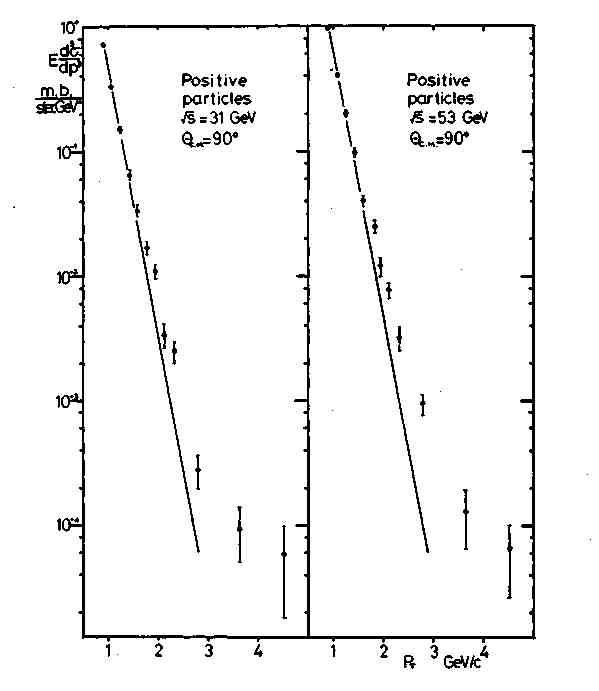
FIGURE 1
The Scandinavian ISR-collaboration has since 1969 prepared experiments on the particle production at large angles with respect to the proton beams, in collaboration with British teams. Since the starting-up of the storage rings, these experiments are now being run and preliminary results have been reported at the Oxford Conference, April 5-7 1972 and at the XVIth International Conference on High Energy Physics in Batavia in September 1972.
Experimental setup
The experimental set-up consists of a magnetic spectrometer with two deflecting magnets mounted on a movable table which allow the very interesting angular range from 35 to 90 with respect to the proton beams to be explored» Particles are detected and their time-of-flight determined by a set of three counter hodoscopes, their trajectories through the spectrometer being determined by 6 magnetostrictive spark chambers. The information is monitored by a small on-line computer and stored on magnetic tape. Up to now about 1500 magnetic tapes with about 20 million events have been recorded and are under analysis.
Preliminary results
Part of the data on the production of pions, kaons and nucleons in the low momentum region have been analysed and has given preliminary results of considerable interest. Figure 1 shows a typical spectrum of the dominant particle kind, pions as a function of the transverse momentum. From these and similar curves at other energies

FIGURE 1
and angles it can be concluded that the particle spectra depend only weakly on the production angle and - except for antiprotons - on the proton energy. When compared with other data at smaller angles it is apparent that the particle distribution as a function of longitudinal velocity v when expressed in terms of the so-called "rapidity" shows a flat energy-dependent plateau for small v, in the centre-of-mass, the length of the plateau increasing with increasing proton energy. These features of the production spectra lend support to the theories proposed by R Feynman, and can be explained in terms of multiperipheral processes.
Results of a more unexpected nature are the discovery of a surprisingly large number of large transverse-momentum particles as can be seen from figure 2. The nature of these particles is not yet known, since our apparatus does not allow particle identification at these high momenta. Other groups have shown that only a small fraction are pions, the most abundant particle type at lower energies. Our apparatus is now being modified to be able to identify completely even high momentum particles by the introduction of threshold-sensitive gas Oerenkov counters.
A search has also been made for the production of particles heavier than the proton in view of the many theoretical speculations about such exotic particles - quarks, heavy leptons» indermediate bosons - and the inherent interest in the dependence of the production rate on the mass of the particle» Deuterons and tritons have been observed but seem to originate almost entirely from collisions in the residual gas rather than between the proton beams. A small number of antideuterons are observed and are probably genuine. If this is confirmed, it will be the first observation of these particles at the ISR.

FIGURE 2
It is hoped to conclude the present experiment at the intersecting storage rings by summer 1973, although discussions are being held with another experimental team using a similar experimental set-up at small angles with respect to the proton beams to follow up the experiments by a combined experiment to study the correlations between the particles produced in the angular ranges of the two experiments. Detailed plans have also been made for a more sophisticated experiment using the so-called Split Field Magnet (SFM), a unique facility in the shape of a huge magnet equipped with multiwire proportional chambers which at present is being assembled in CERN. The Scandinavian ISR-collabora-tion together with teams from Orsay (France) and MIT (USA) have an accepted proposal to study the correlations between particles emitted at large angles with respect to the protons, which would give more detailed information on the problems already investigated in our present experiment. From Lund, S Almehed, T Kivikas and B Lörstad, in addition to the physicists in the present collaboration, have engaged themselves in this new experiment, which would start around the end of 1973.